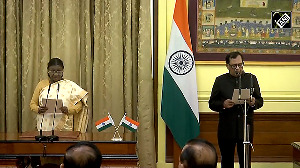‘Cannot say in an unalloyed way that the economy is moving’, cautions MoS finance
 As the finance ministry begins drafting the 2016-17 Union Budget - to be presented in a mere 12 weeks - Minister of State for Finance Jayant Sinha told Business Standard on Tuesday that “three or four themes” would guide the finance ministry through the lengthy and complex process.
As the finance ministry begins drafting the 2016-17 Union Budget - to be presented in a mere 12 weeks - Minister of State for Finance Jayant Sinha told Business Standard on Tuesday that “three or four themes” would guide the finance ministry through the lengthy and complex process.
The first, and major theme, he said, would be the expansion of universal social security, which he hoped would be a historic accomplishment for the National Democratic Alliance government. The roll-out of universal social security would be based on the direct benefits transfer platform, which he said was already working effectively in the employment guarantee programme, for the liquefied petroleum gas subsidy and for pensions and scholarships.
The second theme in the Budget would be agriculture, “an area where we can do much more”. The minister singled out crop health cards, agricultural credit, funding for state-led irrigation schemes among others.
The third theme, Sinha said, would be job creation and the various associated programmes - ‘Make in India’, ‘Skill India’, ‘Start-up India’, and so on. The Union government’s much-anticipated draft start-up policy, he indicated, would be finalised soon but probably not made public till the end of the year or in the New Year.
The Budget’s final theme would be “simplifying the tax structure… Let us see if the committee we have formed has some suggestions by then that we can put in the Finance Bill”.
The Budget drafting process would take place in the context of a recovery in economic growth that Sinha cautioned was “patchy” - there were as yet “not enough data points” to determine if it was broad-based and could be sustained. “The (recently-released) GDP numbers are good but I want to see a real trend before we can say that the economy is really and seriously on an upswing.”
“You cannot say in an unalloyed way that the economy is moving”, he added, adding that the government was facing some significant headwinds: successive below-par monsoons, a commodity meltdown that had hit sectors such as steel and metals, poor export demand and the overhang of stressed assets. Given the headwinds, he said 7.4 per cent growth was “creditable”.
He argued that “every time the Indian economy has done over eight per cent... it has been when exports are strong”. When both agriculture and exports were struggling, “to really power beyond 7.5 per cent is a tall task”.
Nevertheless, he pointed to the government having turned around India’s macro-economic indicators, including the fiscal deficit, in just over a year as an important component towards making a recovery possible. He added that there were several signs, including an increase in the number of hotel rooms booked for business travel, that domestic demand had begun to revive around Diwali. When asked if the government would meet its disinvestment targets - set at an ambitious Rs 69,500 crore (Rs 695 billion) for the ongoing fiscal year - Sinha said simply that “fiscal deficit targets would be met”.
While granting that the quarterly growth numbers were partly driven by front-loaded government spending, he insisted that high public investment could be sustained into the new fiscal year, in spite of the Seventh Pay Commission award and other fiscal stresses: “We have modelled the extra expenditure burden for next year. We can continue to make public investments that are necessary.”
On the prospects for the Goods and Services Tax (GST) Constitution amendment Bill in this session of Parliament, the minister said that the government had earlier managed to build consensus - except for the Congress - in the Select Committee of Parliament, and was “in consultation with colleagues of the Opposition” in order to rebuild that consensus.
Sinha did indicate that the government viewed the GST as just one in a bouquet of broad structural reforms that it intended to undertake, which would create both hard and soft infrastructure, with the “right balance between regulation and market forces”.
The finance ministry’s legislative agenda for the winter session of Parliament extended beyond the GST, he said. The number two priority was the new bankruptcy bill. “Number three on our agenda is the legislative action required to form the Public Debt Management Agency and the Monetary Policy Committee. Apart from that we are working on arbitration and conciliation laws.”
Discussing reform of state-controlled banks, Sinha said that each leadership position would be dealt with on a case-by-case basis, and that they were still open to private sector candidates — if the pipeline of executive directors within the public-sector banking system was not strong enough.
The bank board bureau to advise public-sector banks was a first step towards a holding company, but there were “several moving parts” to handle before a second step was taken, he indicated. It would require legislative approval, and some banks might need to be changed into corporations, which they at present were not.
Meanwhile, he stressed the government would continue to look at the non-performing asset situation, which he said was under control in absolute terms and would be settled through transparent processes.











